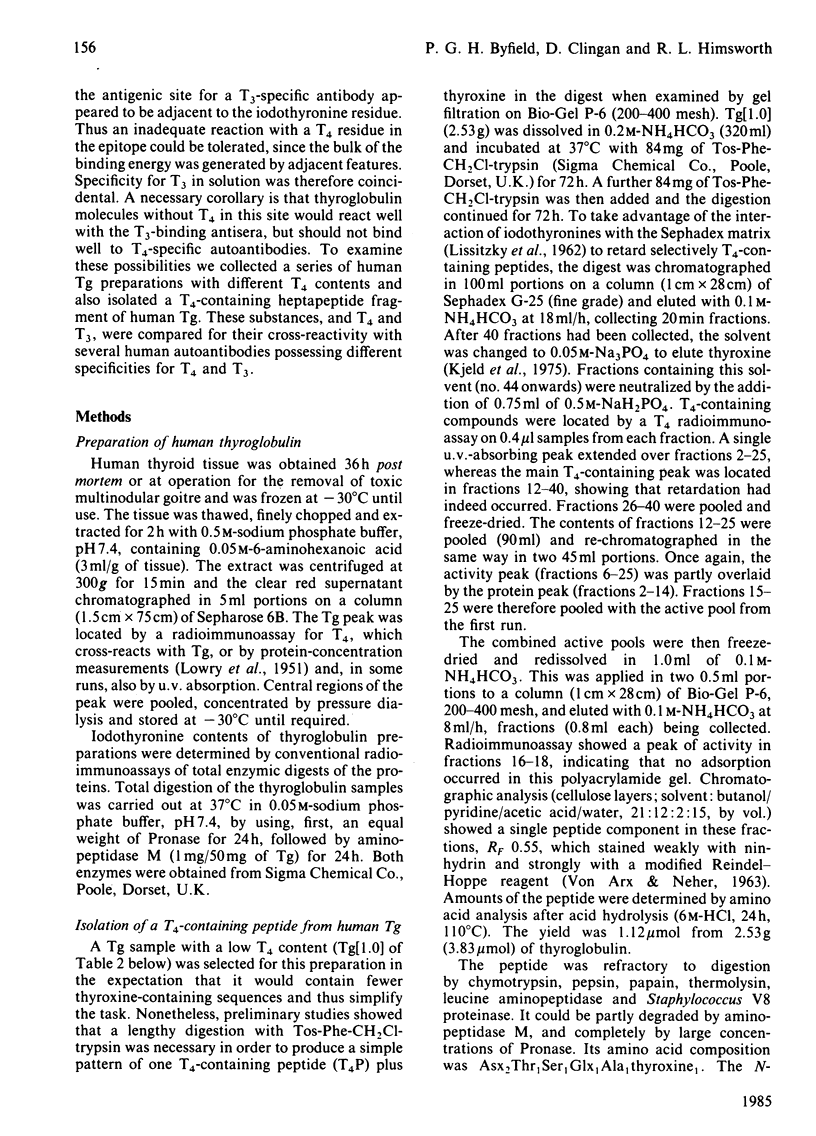Abstract
A series of human autoantibodies against thyroglobulin (Tg) which exhibit different specificities for iodothyronines were studied. The ability of a thyroxine (T4)-containing peptide (T4P) isolated from human thyroglobulin (Tg) to displace [125I]T3 from human T3-specific autoantisera was 11-50 times greater than that of T4 alone. These antisera therefore strongly recognize amino acids adjacent to T4 in the Tg structure. This was confirmed when a Tg preparation (Tg[0.05]) containing an average of only 0.05 of a T4 residue/molecule and much less T3 had good cross-reactivities with these antisera. Cross-reactivities of other Tg preparations with different T4 contents increased only slowly with increase of T4 content up to a mean of 6.6 residues/molecule and were not proportional to T3 content. In contrast, cross-reactivities with a human T4-specific autoantiserum were strongly dependent on T4 content. Tg[0.05] was 500 times less reactive than T4P and 615 times less than T4. Cross-reactivities rose rapidly as the T4 content of Tg preparations increased from a mean of 0.05 to approx. 1-2 residues/molecule. Thyroxine is therefore a dominant feature of the antigenic site for this antiserum. There was little further increase in cross-reactivities for those Tg preparations containing up to an average of 6.6 residues T4 per molecule, confirming previous conclusions that all T4-containing sites are not immunologically identical and that autoantibodies exhibit a preference for particular sites on Tg. Similar conclusions were reached for a non-specific iodothyronine-binding antiserum. These results indicate that iodothyronine specificity in human autoantisera is not necessarily determined by the iodothyronine present in the immunogenic area, but by the precise site selected by the immune response. T4- or non-specific antibodies have thyroxine as a dominant feature of the antigenic site. T3- specific antibodies have the thyroxine residue as a peripheral feature of the binding site, and it is not necessary to postulate that T3 was part of the immunogen or is required in the epitope. These antisera may have value in mapping the hormonogenic regions in Tg from human and other species.
Full text
PDF





Selected References
These references are in PubMed. This may not be the complete list of references from this article.
- Byfield P. G., Bond A., Copping S., Himsworth R. L. Restricted antigenicity of thyroxyls in human thyroglobulin. Biochem J. 1982 Dec 1;207(3):471–478. doi: 10.1042/bj2070471. [DOI] [PMC free article] [PubMed] [Google Scholar]
- Byfield P. G., Clingan D., Himsworth R. L. Exposure of thyroxine residues in human thyroglobulin. Two-site binding studies. Biochem J. 1984 Apr 15;219(2):405–410. doi: 10.1042/bj2190405. [DOI] [PMC free article] [PubMed] [Google Scholar]
- Hartley B. S. Strategy and tactics in protein chemistry. Biochem J. 1970 Oct;119(5):805–822. doi: 10.1042/bj1190805f. [DOI] [PMC free article] [PubMed] [Google Scholar]
- Himsworth R. L., Byfield P. G., Copping S. Studies on the antigenicity of human thyroglobulin. Life Sci. 1983 Jan 3;32(1-2):119–125. doi: 10.1016/0024-3205(83)90179-0. [DOI] [PubMed] [Google Scholar]
- Kjeld J. M., Kuku S. F., Diamant L., Fraser T. R., Joplin G. F., Mashiter K. Production and storage of (125-I) thyroxine and (125-I) triiodothyronine of high specific activity. Clin Chim Acta. 1975 Jun 20;61(3):381–389. doi: 10.1016/0009-8981(75)90428-3. [DOI] [PubMed] [Google Scholar]
- LISSITZKY S., BISMUTH J., ROLLAND M. [Separation of the iodized compounds of serum and the thyroid by filtration on dextran gel (Sephadex)]. Clin Chim Acta. 1962 Mar;7:183–189. doi: 10.1016/0009-8981(62)90007-4. [DOI] [PubMed] [Google Scholar]
- LOWRY O. H., ROSEBROUGH N. J., FARR A. L., RANDALL R. J. Protein measurement with the Folin phenol reagent. J Biol Chem. 1951 Nov;193(1):265–275. [PubMed] [Google Scholar]
- Marriq C., Rolland M., Lissitzky S. Structure-function relationship in thyroglobulin: amino acid sequence of two different thyroxine-containing peptides from porcine thyroglobulin. EMBO J. 1982;1(4):397–401. doi: 10.1002/j.1460-2075.1982.tb01181.x. [DOI] [PMC free article] [PubMed] [Google Scholar]
- Nye L., Pontes de Carvalho L. C., Roitt I. M. Restrictions in the response to autologous thyroglobulin in the human. Clin Exp Immunol. 1980 Aug;41(2):252–263. [PMC free article] [PubMed] [Google Scholar]
- Pearce C. J., Byfield P. G., Edmonds C. J., Lalloz M. R., Himsworth R. L. Autoantibodies to thyroglobulin cross reacting with iodothyronines. Clin Endocrinol (Oxf) 1981 Jul;15(1):1–10. doi: 10.1111/j.1365-2265.1981.tb02741.x. [DOI] [PubMed] [Google Scholar]
- Schneider A. B., Ikekubo K., Kuma K. Iodine content of serum thyroglobulin in normal individuals and patients with thyroid tumors. J Clin Endocrinol Metab. 1983 Dec;57(6):1251–1256. doi: 10.1210/jcem-57-6-1251. [DOI] [PubMed] [Google Scholar]
- VON ARX, NEHER R. EINE MULTIDIMENSIONALE TECHNIK ZUR CHROMATOGRAPHISCHEN IDENTIFIZIERUNG VON AMINOSAEUREN. J Chromatogr. 1963 Nov;12:329–341. doi: 10.1016/s0021-9673(01)83693-1. [DOI] [PubMed] [Google Scholar]


